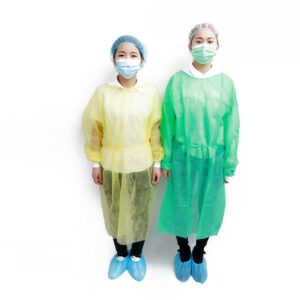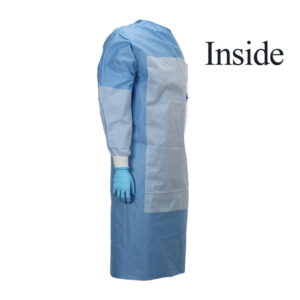Coveralls Type 3B
Protective Coveralls Type 3B is a type of protective clothing that provides barrier protection against liquid chemicals in low concentration. It is typically used in situations where there is a risk of chemical exposure.
Materials of Protective Coveralls Type 3B:
Protective Coveralls Type 3B is commonly made of a laminated microporous material that provides a combination of breathability and protection. The material is usually composed of a polyethylene layer, which provides the protective barrier, and a nonwoven layer, which provides the breathability.
Specifications of Protective Coveralls Type 3B:
The common specifications for Coveralls Type 3B include a full-body coverage design with long sleeves and legs, elastic cuffs and ankles, a zipper front with storm flap, and a hood to provide head protection. The size range varies depending on the manufacturer and can range from small to extra-large.
Applications of Protective Coveralls Type 3B:
Coveralls Type 3B is suitable for use in a wide range of industries including pharmaceuticals, chemicals, agriculture, manufacturing, and petrochemicals. It is designed to protect the wearer from exposure to liquid chemicals and particles.
Additional information
Product Details:
Chemical protective clothing serves as a vital safeguard for individuals exposed to hazardous chemicals. It shields the head, torso, arms, and legs from chemical substances. These garments are categorized into Level 1 and Level 2 chemical protective suits, each designed for specific protection requirements.
Level 1 Chemical Protective Suit:
Structure: Fully sealed one-piece design.
Components: Includes an integrated hood with a large viewport, chemical protective suit, positive-pressure self-contained breathing apparatus backpack, chemical-resistant boots, and chemical-resistant gloves.
Color: Yellow.
Level 2 Chemical Protective Suit:
Structure: One-piece design ensuring complete coverage of the wearer.
Variation: Can adopt the structure of Level 1 protective suits.
Color: Red.
Functionality:
Chemical protective suits, regardless of level, provide comprehensive protection for the head, torso, arms, and legs, guarding against chemical exposure. Level 1 suits offer a sealed ensemble with added features like a large viewport and a positive-pressure respirator, while Level 2 suits ensure complete coverage with the flexibility to adopt Level 1 suit features.
Understanding the distinctions between Level 1 and Level 2 chemical protective suits is crucial for selecting the appropriate attire based on the specific chemical exposure risks. The color-coded classification simplifies identification, enhancing safety protocols in environments where chemical hazards are prevalent.
Quality Parameters for Chemical Protective Clothing
1. Exterior Quality:
The fabric surface of chemical protective clothing should be smooth, and free from holes, bubbles, delamination, exposed threads, and dead folds. Chemical protective boots must exhibit no signs of tooth detachment, air gaps, adhesive peeling, frosting, over-sulfuration, or under-sulfuration. The outer tapes of chemical protective suits should be neatly arranged without any missing components.
2. Overall Airtightness:
For Level 1 chemical protective suits, the overall airtightness should be equal to or less than 300Pa.
3. Overall Water Permeability Resistance:
Level 2 chemical protective suits should show no leakage after a 20-minute test.
4. Positive Pressure Exhaust Valve:
For Level 1 chemical protective suits, the airtightness of the exhaust valve should be greater than or equal to 15/s, and the ventilation resistance should be between 78-118Pa.
5. Fabric Performance:
Tensile strength should be greater than or equal to 9kN/m.
Tear strength should be greater than or equal to 50N.
Flame resistance should meet conditions of ignition and non-ignition with a time limit of equal to or less than 10s, and the damage length should be equal to or less than 10cm.
In the chemical permeation resistance test for clothing fabric and seam areas, the average permeation time should be greater than or equal to 60 minutes.

Advantages:
- Effective Barrier Protection: Coveralls Type 3B provides an effective barrier against liquid chemicals and particles, protecting the wearer from exposure to harmful substances.
- Breathable Material: The laminated microporous material used in the coveralls provides breathability, allowing the wearer to remain cool and comfortable for extended periods of time.
- Comfortable Fit: The elastic cuffs and ankles, as well as the hood and full-body design, ensure a comfortable and secure fit for the wearer.
- Easy to Wear: The zipper front with storm flap design makes it easy to put on and take off the coveralls, even while wearing gloves.
- Cost-Effective: Coveralls Type 3B provides an affordable solution for protecting workers from chemical exposure, reducing the risk of accidents and injuries in the workplace.
Maintenance and Precautions for Chemical Protective Clothing
1. Thorough Inspection Before Use:
Before usage, a meticulous examination of the protective clothing for any damages is essential. If any damage is detected, usage is strictly prohibited.
2. Avoid Direct Contact with Flames and Melting Substances:
Chemical protective clothing should not come into direct contact with flames or melting substances.
3. Proper Usage Guidelines:
During use, it is crucial to ensure a tight fit between the hood and the mask. The neck buckle, chest’s large white buckle, and waist belt must be securely fastened to guarantee good airtightness around the neck and chest, minimizing the “bellows effect” during movement.
4. Post-Use Cleaning Procedure:
After each use, clean the clothing with soapy water or a 0.5~1% sodium carbonate solution based on the level of contamination. Subsequently, rinse thoroughly with clean water and allow it to dry in a cool and ventilated area before packaging. solution based on the level of contamination. S
5. Storage Conditions:
Chemical protective clothing should be stored away from heat and direct sunlight. It must not come into contact with active chemicals or various oils during storage.
6. Shelf Life:
Under standard storage conditions, the product has a shelf life of five years, adhering to the specifications outlined in the standards.









